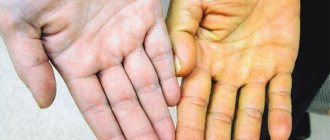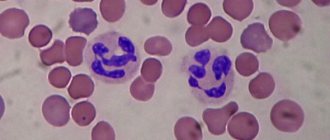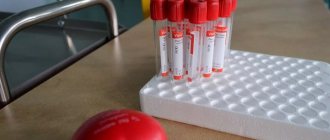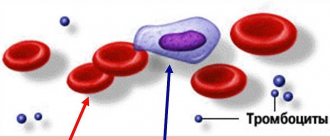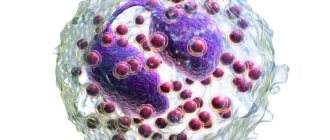Functions of red blood cells
Erythrocytes, or red blood cells, take their name from the Greek erythros - red, and cytos - cell. Not only do they make up the majority of all blood cells , but overall they form about ¼ of the total number of cells in the human body. The calculations carried out are interesting: if all 25 trillion red blood cells found in the human body were laid out in one chain, then it would encircle the Equator three times.
Red blood cells do not have a nucleus, but most of the cell is occupied by the protein hemoglobin, which contains iron ions. It is this that provides the red color and the main function to these cells. Hemoglobin is able to create temporary bonds with oxygen and transfer it to all organs and tissues through the bloodstream. Oxygen is absorbed by cells and is necessary for metabolic processes.
The carbon dioxide released by the cells is also bound by hemoglobin and sent through the bloodstream into the pulmonary circulation to the lungs. There it is released into the alveoli and removed from the body with exhalation. When you inhale, oxygen from the alveoli enters the blood, binds to hemoglobin and is sent through the systemic circulation throughout the body. These 2 vital processes occur in the body constantly.
This is the main function of red blood cells, but they are also involved in the transport of amino acids, lipids, electrolytes, and are involved in maintaining the acid-base balance and in the process of blood clotting.
Norm of red blood cells in adults and children
Red blood cells are formed from stem cells in the red bone marrow of spongy bones - ribs, spine, skull, in children and in long bones. Every second, several million of them are formed, and the same number are destroyed - in the spleen (it is called the “graveyard of red blood cells”) and partly in the liver. The lifespan of an erythrocyte is 3-4 months.
Often these processes are disrupted - both normally and in various diseases. Therefore, the average values of the content of erythrocytes in the blood, which ensure normal metabolism in cells, have been determined. For men, this norm is 3.9-5.5 x10 to the 12th power in 1 liter of blood (or million per 1 ml), for women it is slightly lower - 3.9-4.7 million/ml.
In children before puberty, the number of red blood cells in boys and girls is the same. The normal level of red blood cells in the blood depending on age is presented in the table:
| Child's age | Red blood cell rate (million/µl) |
| 1 – 14 days | 3,9 – 5,9 |
| 15 days – 4 weeks | 3,3 – 5,3 |
| 5th week - 4 months | 3,5 – 5,1 |
| 4 to 6 months | 3,9 – 5,5 |
| 6 to 9 months | 4,0 – 5,3 |
| 9 to 12 months | 4,1 – 5,3 |
| From 1 year to 3 years | 3,8 – 4,8 |
| From 3 to 6 years | 3,7 – 4,9 |
| From 6 to 9 years | 3,8 – 4,9 |
| From 9 to 12 years | 3,9 – 5,1 |
In adults, the norm depends on both age and gender:
| Age | Women | Men |
| 12 – 15 years | 3,8 – 5,0 | 4,1 – 5,2 |
| 16 – 18 years old | 3,9 – 5,1 | 4,2 – 5,6 |
| 19 – 45 years old | 3,8 – 5,1 | 4,3 – 5,7 |
| 46 – 65 years old | 3,8 – 5,3 | 4,2 – 5,6 |
| Over 65 years old | 3,8 – 5,2 | 3,8 – 5,8 |
A decrease in the number of red blood cells per unit volume of blood is called erythropenia. It can be of 2 types:
- Physiological, not associated with pathological processes;
- Pathological, associated with hematopoietic disorders and other diseases.
Physiological causes of decreased red blood cells
A physiological decrease in red blood cells can be of 2 types: absolute, when their total number decreases, and relative, when their total number is not changed, but the concentration in the blood is reduced.
An example of absolute physiological erythropenia is a decrease in the number of red blood cells during pregnancy. This is due to the formation of the hematopoietic system and organs in the fetus and the increased consumption of iron and protein ions. As a result, fewer red blood cells are produced due to this deficiency. Their level during pregnancy can decrease to 3 million/µl, this is considered normal.
In pregnant women, there is also another reason - an increase in the volume of fluid in the body and some thinning of the blood, which reduces the concentration of red blood cells.
Relative erythropenia develops with a large intake of fluid into the body, for example, heavy drinking, intravenous infusions, as a result of which the blood is diluted and the concentration of red blood cells per unit volume decreases.
Symptoms and treatment
When the number of red blood cells decreases, a person may experience weakness, dizziness, and fatigue. The skin usually turns pale; with hemolytic anemia, the skin may acquire a jaundiced tint. With the hereditary nature of the disease, an enlargement of the spleen is observed.
This condition requires a complete examination of the patient. In addition to blood tests, instrumental examinations of internal organs are prescribed to identify the cause of the disease. Treatment tactics mainly depend on the identified cause of the decrease in red blood cells and are aimed primarily at eliminating it.
Diseases that cause a decrease in red blood cells
A decrease in red blood cells associated with diseases is called anemia, when the total number of red blood cells and their concentration in the blood decreases. There are the following groups of causes of pathological erythropenia:
Insufficient erythropoiesis
For the formation of red blood cells, protein, iron, folic acid, and vitamin B12 are needed. If there are not enough of them in the body, anemia develops. This happens with a lack of nutrition, as well as with impaired absorption of these substances - with diseases of the stomach and intestines.
Blood loss
Bleeding can be traumatic or associated with a bleeding disorder, and can be external or internal. With blood loss, both the content of red blood cells and hemoglobin always decrease.
Hereditary blood diseases
These are genetic disorders in which defective “short-lived” red blood cells are formed; their destruction exceeds the process of formation (Choffard’s disease, microspherocytosis, erythroenzymopathies and other anomalies).
Oncological diseases
In oncopathology, there may be cancer cells (metastases) in the hematopoietic organs. The formation of red blood cells is also inhibited by cancer intoxication, chemotherapy and radiotherapy courses.
Autoimmune diseases
When the immune system malfunctions, when antibodies are formed to one’s own cells (lupus, rheumatoid arthritis, Crohn’s disease).
Infections in the body
During bacterial, viral, and parasitic infections, the released toxins inhibit the function of hematopoiesis and reduce the lifespan of red blood cells.
Toxic effects
Inhibition of erythropoiesis can occur with any acute or chronic intoxication, including alcohol. Medications such as phenobarbital, chemotherapy drugs, some antibiotics, sulfonamides, and excessive intake of anti-inflammatory nonsteroids (paracetamol and analogues) have a negative effect.
Reduced red blood cells in the blood in pregnant women
Let's look at why red blood cells in the blood may be low during pregnancy. Their number in pregnant women may decrease due to fluid retention and an increase in circulating blood volume, that is, this decrease is relative. Along with this, some decrease occurs due to a lack of iron, protein, folic acid, which are spent on the development of fetal organs.
Permissible deviations from the norm during pregnancy:
| Trimester of pregnancy | Permissible fluctuations in million/ml |
| 1st | 4,2 – 5,4 |
| 2nd | 3,5 – 4,8 |
| 3rd | 3,7 – 5,0 |
As can be seen from the table, in the 1st trimester, red blood cells may be slightly elevated due to toxicosis and loss of fluid through vomiting, and blood thickening. In the 2nd trimester, their level decreases due to the active consumption of iron and protein by the fetus, and by the end of pregnancy it usually returns to normal. An amount below 3 million/l is considered critical, when anemia develops and treatment is necessary.
During pregnancy, it is necessary to monitor the level of red blood cells in the blood.
Treatment
Before prescribing treatment for low red blood cells in the blood during pregnancy, the doctor will refer the patient for a repeat blood test. This will help eliminate a possible error or once again confirm the problem. A pregnant woman will have to follow a few simple rules before taking the test:
- avoid emotional turmoil;
- minimize physical activity;
- Do not eat new or unhealthy foods for 24 hours.
You need to take the test in the morning, on an empty stomach (at least 10 hours must pass after eating). At the same time, you are allowed to drink clean still water.
The treatment regimen will depend on the cause that provoked the decrease in red blood cells during pregnancy. If it was an unbalanced diet or an inactive lifestyle, the specialist will give the woman general recommendations regarding diet and permitted physical activity.
A pregnant woman's diet should contain a sufficient amount of vitamins and minerals. Don't give up daily walks in the fresh air.
For infectious and other diseases, the main focus is on their treatment. The level of red blood cells, in this case, will have to recover on its own.
If the problem is associated with severe blood loss, specialists will select special therapy to quickly restore the patient’s body. These can be various iron-containing preparations and vitamins that will promote hematopoiesis. In addition, such patients will be advised to drink more fluids and introduce foods with a high iron content into their diet: dried mushrooms, beef liver, cocoa, green beans, strawberries, blueberries, beef, rabbit, carrots, eggs.
If there are serious health problems, such as anemia or malignant neoplasms, the pregnant woman will be treated in a hospital setting and under the constant supervision of medical personnel.
Causes of low red blood cells in a child’s blood
A child normally should not have a decrease in the number of red blood cells in principle, so erythropenia in a blood test should always be alarming. In newborns, the cause of erythropenia may be hemolytic anemia or a hereditary, genetic blood disease. However, it is not uncommon to experience slight anemia after birth due to a conflict with the mother's antibodies.
At an older age, the cause may be injuries, internal hematomas, which the child cannot always talk about, as well as dysfunction of the digestive organs and malnutrition of the child. If a child’s red blood cells are reduced to 3.2 µm/ml or lower, this leads to disruption of his development - of all organs and systems, requiring treatment.
In any case, all these issues are decided by a neonatologist, and if necessary, by a pediatric hematologist.
Why downgraded?
Reduced red blood cells in the blood are a consequence of physiological and pathological processes. A condition in which there are fewer blood cells than normal is called erythropenia. Physiological reasons: pregnancy and menstruation in women, a sudden change in diet with insufficient meat consumption.
Analysis shows a reduced content of corpuscles in people who often drink alcohol and smoke. Certain medications and their long-term use can affect the fact that the cells are lower than normal. But if the percentage of FL red blood cells is constantly reduced, this is a sign that pathological processes are occurring in the body.
Acute or chronic blood loss
Low red blood cells in the blood are observed during bleeding that occurs as a result of trauma or wounds. Chronic, extensive bleeding can be asymptomatic; the only thing that indicates internal bleeding in the patient is slight weakness and a low level of blood cells in the analysis. Bleeding leading to a decrease in the concentration of corpuscles occurs when:
- anal fissures, acute and chronic hemorrhoids;
- ulcer of the duodenum, stomach;
- varicose veins in the esophagus;
- systemic lupus erythematosus;
- rheumatism;
- atherosclerosis.
A strong decrease in the concentration of red blood cells is observed during uterine bleeding caused by miscarriages, abortions, and surgical interventions. If the bleeding was minor and went away on its own, the cell level will return to normal within a fairly quick period of time.
Insufficient production of red blood cells
A constantly low level of cells in the blood is observed with dysfunction of the bone marrow, which cannot produce them in the required quantity. The cause is cancer of the bone marrow. Insufficient production of red blood cells may be due to the fact that the body does not have vitamin B12, or its concentration is low.
Hereditary blood diseases
The fact that few red blood cells are constantly found in the blood means the presence of congenital blood diseases, which include:
- leukemia;
- hereditary fermentopathy;
- membranopathy;
- hemolysis;
- sickle cell anemia.
In this case, the child will have a clinical picture corresponding to the disease; an insufficient level of red blood cells is detected after birth.
Enhanced Destruction
Red blood cells in the blood are low due to abnormal processes in the body. This means that the bodies are produced in full, but quickly die under the influence of a number of factors. The latter include autoimmune diseases, when the body produces antibodies that attack its own blood cells.
Increased destruction of corpuscles is observed in diseases such as splenomegaly (enlarged spleen). Red blood cells, due to their plasticity, can pass even through those organ vessels that are much smaller in diameter. But due to hereditary membranopathy, they lose their elasticity, cannot pass through the vascular walls, which is why they settle in the sinuses, where they are actively destroyed by macrophages of the spleen.
Important information: What is LYM (LYMPH) in a blood test and decoding the norm is increased or decreased
Infection
A decrease in the number of red blood cells is observed in a number of infectious diseases:
- rubella;
- cytomegaly;
- congenital syphilis;
- malaria;
- toxoplasmosis.
Infectious pathogens destroy the bodies, leading to a decrease in their numbers.
Oncology
If the number has decreased to a critical level, this may be a sign of the development of cancer in the body. A tumor can develop in the bone marrow, leading to its dysfunction and inability to produce cells in the required quantity. This clinical picture is observed in leukemia, a malignant blood pathology. A low number of red blood cells is typical during chemotherapy.
Autoimmune diseases
When the body produces antibodies that attack its own red blood cells, autoimmune anemia develops. Such diseases include:
- systemic lupus erythematosus;
- Hodgin's lymphoma;
- rheumatoid arthritis;
- lymphocytic leukemia in a chronic course.
Taking certain medications
Long-term use of antibacterial drugs: Corvalol, cytostatics and analgesics can affect the concentration of erythrocyte bodies, leading to a decrease in their number.
Symptoms of low red blood cell levels
A decrease in the level of red blood cells in the blood is manifested by symptoms of anemia, which is characterized by:
- Paleness of the skin and mucous membranes;
- Headaches and dizziness;
- Tinnitus;
- Dark circles before the eyes;
- General weakness, malaise;
- Reduced blood pressure;
- Increased heart rate;
- Increased skin moisture, sweating.
The severity of the symptoms will depend on how quickly the anemia develops. In its chronic course, they will be erased, the body gradually adapts to the lack of red blood cells. In case of acute anemia, for example, blood loss, intoxication, acute leukemia, all symptoms will be pronounced, including fainting and loss of consciousness.
Diagnostics
If erythropenia is suspected, a general blood test is performed. Hemoglobin, number, configuration and size of RBC cells are determined. The formation of atypical cells indicates the onset of the disease. A special test is taken for total serum iron-binding capacity (TIBC) to determine the level of iron in hemoglobin.
Based on the test results, the doctor determines the type and condition of red blood cells in the blood. Medicines are prescribed.
Sometimes the disease occurs in a latent form with normal biochemical parameters. Then additional tests for erythrocyte indices are prescribed:
- mean erythrocyte volume (MCV);
- average hemoglobin content in erythrocytes (MSH);
- average hemoglobin content in erythrocyte mass (MCHC);
- coefficient of average erythrocyte volume (RDW).
Analysis and analysis of the main and auxiliary indicators of the disease clarifies and details the primary diagnosis. The main goal of medical procedures is the quantitative norm of red blood cells. When the treatment achieves its goal, the body's physiology also comes into balance.
Diagnostics of deviations
Diagnosis of erythropenia is aimed at finding out its cause. In a clinical blood test, in addition to the concentration of red blood cells, the hemoglobin content, the color indicator of blood, and hematocrit (the ratio of the liquid part to the cellular composition) are determined to determine whether erythremia is true or relative.
They also determine the presence of pathological forms of red blood cells that appear in anemia and many diseases. If no obvious cause is identified (for example, bleeding or poisoning, acute infection, and so on), then a full examination is prescribed: biochemical, immunological tests, CT and ultrasound of organs, gastroscopy, testing for tumor markers, PCR analysis to determine infection, genetic tests.
How to increase red blood cells
To normalize the level of red blood cells, drugs alone are not enough. Treatment should be comprehensive, including medications, diet therapy, and normalization of lifestyle.
Drug treatment
Includes drugs:
- Stimulating erythropoiesis (erythrostim, erythropoietin, recormon, binocrit and others);
- Preparations of 2- and 3-valent iron (ferrum-lek, maltofer, ferlatum, actiferrin, sorbifer and others);
- Folic acid - vitamin B9 (in pure form or in combination with vitamin B12 - foliber, with vitamins B12 and B6 - evalar, with iron - maltofer, hemoferon);
- Vitamins A, C, E, microelements (aevit, vitamin-mineral complexes).
The dose and form of drugs (tablets or injections) should be prescribed by a doctor, based on the form, severity and cause of anemia.
Diet therapy and lifestyle
There are also methods to increase red blood cells in the blood at home. The diet should include foods high in protein, iron, vitamins and microelements. For anemia, the following are recommended: red meat, liver, eggs, beans, lentils, buckwheat, cabbage, spinach, beets, carrots, greens, nuts, dried fruits, honey, chocolate.
If you have anemia, you will have to give up bad habits - completely eliminate alcohol and smoking. You need to organize proper rest and sleep, choose a time for sports, at a minimum - daily hygienic exercises, walking.
In severe cases, the patient is treated in a hospital : a blood or red blood cell transfusion is given. Treatment of the underlying disease causing the anemia is prescribed.
Causes of the disease
- Blood loss. As a result of injury, accident or after a major operation, a lot of blood is lost in an acute form. With heavy menstruation in women, hemorrhoidal bleeding, stomach ulcers and other chronic disorders, a deficiency of blood occurs in the body.
- Decreased reticulocyte production. This reason is associated with a lack of iron and folic acid in the diet. A decrease in the amount of these components occurs when the digestive cycle is disrupted.
- Accelerated aging and destruction of RBC. The concept of a healthy cell implies going through a full life cycle. When RBCs are exposed to toxins, the vital resource is used up ahead of schedule. If we talk about erythrocytosis, the disease can take a latent form with a simultaneous increase in the production and destruction of red blood cells.
- Strong effect of drugs. Antibiotics disrupt the functioning of the bone marrow and also directly affect the red blood cell. Anemia occurs as a reaction to the sharp effects of antibiotics, breaking the previous balance.
- Bone marrow diseases. Dysfunction or malignant tumors in the bone marrow disrupt the functioning of stem cells, and reticulocytes do not enter the blood.
- Poisoning with hemotropic poisons. This group includes snake and mushroom venoms. The effect is expressed in changes in the properties of RBC, leading to coma and death.

